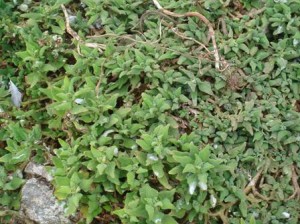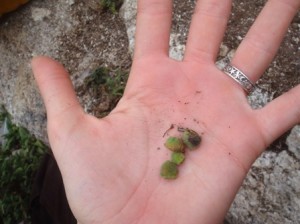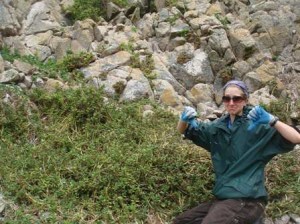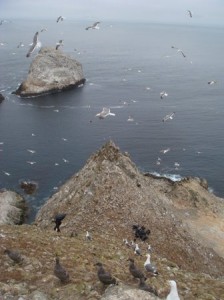The Farallon Islands, like almost every island that has experienced human presence or traffic, have a pretty serious problem with invasive plants. The worst of these invasives, by far, is the New Zealand Spinach.
New Zealand Spinach is a spinach, as in, you can eat it, but the one time it was ever served out here, I hear it was awful–really salty. However, a recent report on NPR which focused on “urban scavengers” did include an interview with a guy who claims it’s really tasty. Well, maybe, but at least not out here. In addition, the spinach is a really awful, annoying plant.
As you can see, it’s a very dense plant, and it’s dense root-structure interferes with the ability of burrowing birds (out here Cassin’s Auklets and Rhinocerous Auklets) to build their burrows. In addition, it chokes out the Farallon Weed, the main endemic plant out here.
The war against spinach is somewhat of a Catch 22. Around this time of year, the end of July, the spinach plants go to seed, each one dropping hundreds of tiny seeds. Once a plant has seeded, it’s almost not worth trying to pull it up, because the damage has been done. So, then, it seems that the obvious thing to do would be to try to pull the spinach before it seeds, possibly even as early as June. The problem with this plan is that so many of the areas on the island are completely off-limits in June. Pulling spinach would cause immeasurable damage and disturbance to the breeding seabird populations, so there’s almost no way to keep a lot of the plants from dropping seeds.
Before I continue my story, one thing you have to understand is that the entirety of Southeast Farallon Island is a wildlife refuge. There are, however, wilderness areas on the island that pretty much no one is allowed into. One of these wilderness areas, over by North Landing, hasn’t been visited by PRBO staff for probably around 20 years. This year, however, we’ve noticed from far away that a lot of large mats of spinach were cropping up in the area. So, we got permission from the refuge manager to head over there and pull the spinach. This turned out to be very complicated.
First of all, getting to the area would be simple, except for the fact that a bunch of Pelagic Cormorant nests sprang up right in the clearest path to the area, so we couldn’t go that way. Instead, we decided to take the long way around, up Lighthouse Hill, down the ridge, across a couple of other ridges, and into the wilderness area. This is a LONG, DIFFICULT, and relatively dangerous path, since for the majority of it you’re creeping along cliff faces trying not to dislodge the mixture of loose rocks and gravel (“scree”) that make up the body of Lighthouse Hill. In addition, Fish and Wildlife protocol stated we had to bleach our shoes before heading over there, AND we had to bring all the spinach we pulled out in bags. (Normally, when we pull spinach, we just turn it upside down on a rock and let it dry out. Not this time though.)
It took about half an hour to walk over to the wilderness area, and once there, a couple of hours to pull all the spinach. Lots of the plants were in huge mats, with individual plants weighing around twenty pounds once we pulled them.
In addition to pulling the plants, we spent some time picking seeds out of the dirt, but this is a pretty hopeless task, since there’s no way we’ll ever get all the seeds. Every little bit helps though!
Ultimately, we ended up with eighteen contractor bags full of spinach. Limited by the number of bags we had brought, we stuffed them all very full, and each of them easily weighed between forty and fifty pounds.
Remember when I said that the trip over to the wilderness area was difficult? Well, to put it mildly, it was NOT easier when lugging a forty pound bag of spinach on your back. We ended up sort of daisy-chaining the bags as frequently as we could, passing them along from flat area to flat area. Sometimes, though, we just had to buckle down and lug them fairly long distances with nowhere to stop.
The spinach work ended up taking about five hours, all afternoon, and left everyone more exhausted than I remember being since I got here. Good thing I’m not cooking tonight!
Anyway, I can’t believe I’ve only got three days left here. Over the next few days, I’ll be transferring my studies over to other people, to continue until they conclude.
Well, Hannah’s making thai coconut soup tonight, which is smelling delicious, and we’ll probably watch a movie tonight, since Rhino netting ended last night. No night work tonight!!
That’s all for now.
Best,
Eleanor





